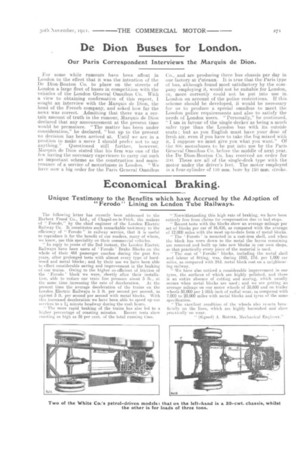Economical Braking.
Page 9

If you've noticed an error in this article please click here to report it so we can fix it.
Unique Testimony to the Benefits which have Accrued by the Adaption of "Ferodo " Lining on London Tube Railways.
The following letter has recently been addressed to the Herbert -Frond Co., Ltd., of Chapel-en-le-Frith, the makers of " Ferodo," by the chief engineer of the London Electric Railway Co. It constitutes such remarkable testimony to the efficiency of " Feroda " in railway service, that it is useful to reproduce it for the benefit of our readers, many of whom, we know, use this speciality on their commercial vehicles.
" In reply to yours of the 2nd instant, the London Electric Railways have been users of • Ferodo ' Brake Blocks on the whole of their 464 passenger coaches during the past five years, after prolonged tests with almost every type of hardwood and metal blocks; and by their use we have been able to effect considerable saving and improvement in the braking of our trains. Owing to the higher co-efficient of friction of the Ferodo ' black we were, shortly after their installation, able to reduce our train line pressure about 5 lb., at the same time increasing the rate of deceleration. At the present time the average deceleration of the trains ou the London Electric Railways is 5 ft. per second per second, as against 3 ft. per second per second with metal Mocks. %kith this increased deceleration we have been able to speed up our services to a 1 minute headway during the rush blurs. " The more rapid braking of the trains has also led to a higher percentage of coasting minutes. Recent tests show roasting as high as 38 per cent, of the total running time. " Notwithstanding this high rate of braking, we have been entirely free from claims for compensation due to bad stops. " Recent tests with the blocks show an average mileage per set of blocks per car of 16,416, as compared with the average of 12,000 miles with the most up-to-date form of metal blocks.
" The Fend() ' is mounted in a cast-iron shell, and when the block has worn down to the metal the layers remaining are removed and built up into new blocks in our own shops, so that practically every piece of the material is used. " The cost of Ferodo blacks, including the metal shell and labour of fitting. was, during 1910, 17d. per 1,000 car miles, as compared with 24d. metal block cost on a neighbouring railway. " We have also noticed a considerable improvement in our tyres, the surfaces of which are highly polished, and there is an entire absence of cutting and scoring, which usually occurs when metal blocks arc used; and we are getting an average mileage on our motor wheels of 35,600 and on trailer wheel's 50,000 per 1-16th inch of radial wear, as compsred with 7,000 to 20,000 miles with metal blocks and tyres of the same specification.
• "rhe excellent condition of the wheels also re-acts berte, ficially on the lines, which are highly burnished and show practirally no wear.
" (Signed) A. Rozwa. 3lechanieal Engineer."




















